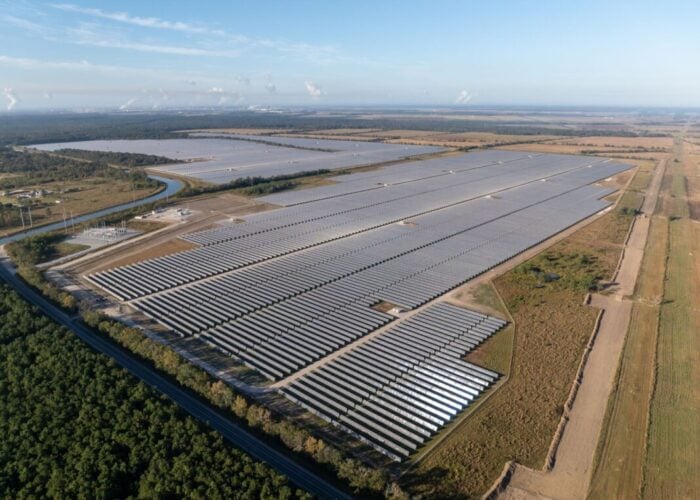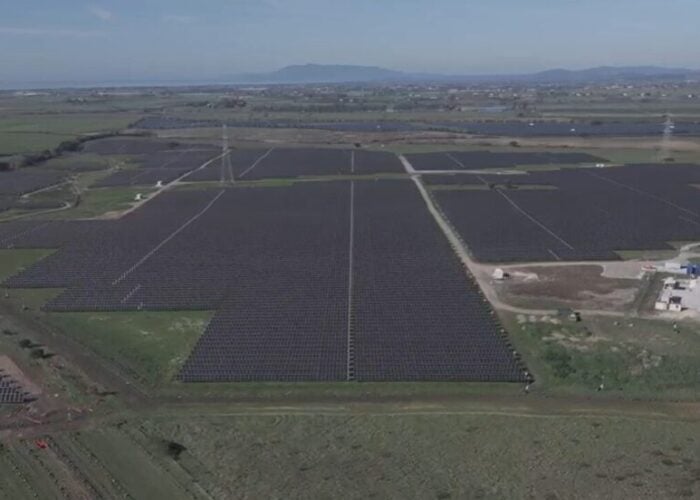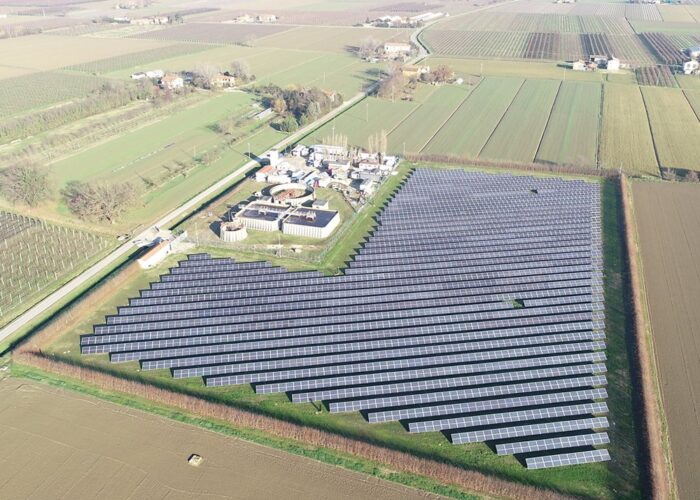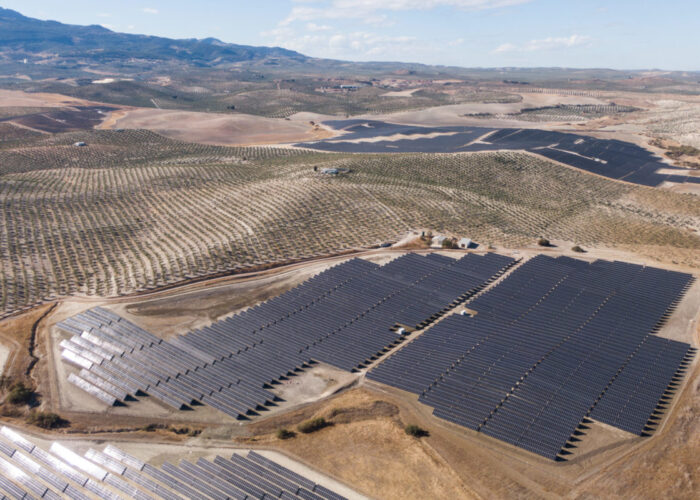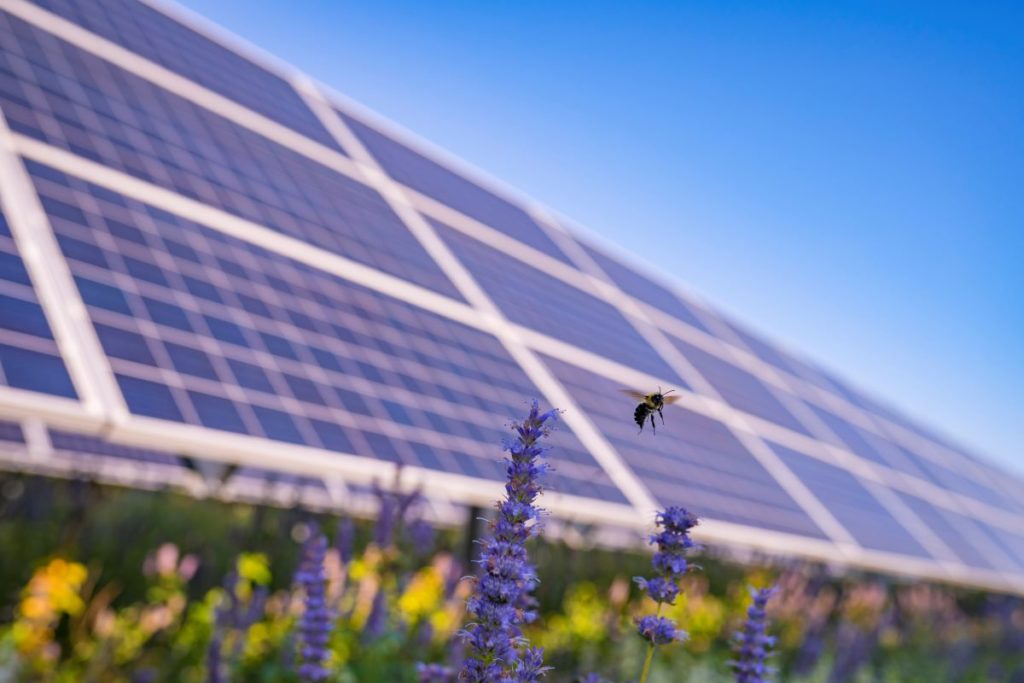
A solar energy project in Italy integrated with agricultural production of olive oil, medicinal herbs, and forage for livestock, will help to “re-balance” what is said to be a “false-narrative” around the amount of land needed for agrivoltaics, a representative of the developer Enel Green Power has told PV Tech Premium. The project uses shading from the PV modules to increase crop yields, while an increased albedo effect from the crops also boosts the energy production from the project’s bifacial modules, says Eleonora Petrarca, head of business development Italy at Italian renewables giant Enel Green Power.
Italy’s forthcoming largest solar plant, standing at 170MW capacity, is also an agriPV plant that integrates energy production from the PV arrays with agricultural production placed between the solar infrastructure and along its perimeter. Back in March, Enel started constructing the record-breaking facility, the Piani della Marina project in the municipality of Tarquinia in the Lazio Region.
Unlock unlimited access for 12 whole months of distinctive global analysis
Photovoltaics International is now included.
- Regular insight and analysis of the industry’s biggest developments
- In-depth interviews with the industry’s leading figures
- Unlimited digital access to the PV Tech Power journal catalogue
- Unlimited digital access to the Photovoltaics International journal catalogue
- Access to more than 1,000 technical papers
- Discounts on Solar Media’s portfolio of events, in-person and virtual
Panel layout
Asked if the agriPV panels will take up more surface area than standard PV projects, Petrarca says that the area covered is exactly the same. Crops are located in the spaces between the modules’ structures, which impacts neither the layout of a usual ground-mounted PV power plant, nor its performance. This agriPV configuration, which is usually called the ‘standard agrivoltaics model’, is strongly promoted and developed by Enel Green Power in many Italian regions and by many players in the sector of utility-scale solar development.
The ‘Standard agrivoltaics model’ doesn’t need incentives and is one of the most efficient sources of energy production to support Italy’s energy transition to match green targets, adds Petrarca.
Crop albedo
The project uses bifacial modules mounted on trackers, with the crops even marginally increasing the albedo effect for irradiation hitting the backside of the modules rather than dulling it.
“The agronomic study carried out from the very beginning of the project supported the choice of coupling forage and borage with the PV project, considering that these crops can be cultivated between the rows of PV trackers,” says Petrarca. “Furthermore, thanks to the slight increase in the albedo linked to these identified crops, it has been estimated that energy production yearly could increase by approximately +0.2%.”
Trackers and shade help crop yields
The PV panels also create areas of shade on the soil, which can improve microclimate conditions. During in-field tests carried out by Enel Green Power in other countries, this shading effect can lead to an up to 50% potential increase in the agricultural yield of the forage grown in the free PV areas between the rows of trackers. It also led to an up to 20% potential reduction in water consumption, as well as improved protection of plants from heat peaks and thermal stress.
Olive oil, mowing and medicinal borage
The agronomic study for the Tarquinia agriPV project supported use of mixed forage crops (80 hectares) and borage (10 hectares) in the available areas between the rows of trackers, with olive trees planted in the perimeter strip (4 hectares), to integrate the PV project harmoniously into the territory.
The host location has pedo-climatic conditions, which means it is an area of relatively homogenous soil type and climate conditions. The crops selected are composed of native plants that can achieve optimal productive and qualitative results in such conditions.
The forage is harvested by mowing annually, followed by a baling operation using special agricultural machinery. The product will be used by Enel Green Power’s agricultural partner, both to meet internal needs linked to its livestock activities and for sale to third parties.
“The borage that will be chopped after the flowering and fruiting phases is a medicinal species that has a limited water requirement and is rather suitable for mechanised management of all the required processes,” adds Petrarca.
Again the company’s agricultural partner will use the harvest for food purposes both on its farm and for sale to third parties.
Organic olive oil will also be produced from the olive trees growing on the perimeters, to be sold by the agricultural partner through several sales channels. Petrarca says the olive trees will be planted along most of the perimeter of the facility, not between the rows of trackers, and there is no threat of the trees causing shading that could negatively impact the energy production of the solar PV plant.
Cultivating biodiversity
The three main crops, olive trees, borage and the various forage plants were also chosen to support biodiversity at the project site.
“In particular, borage is a melliferous herbaceous plant which is also known as ‘bee-bread’ precisely due to bees’ attraction towards it,” says Petrarca. “The inclusion of this melliferous species aims to promote the protection of biodiversity through the precious role of bees.
“Borage flowers, despite being typical in spring and lasting some time, blossom rather early in our areas and usually beginning with a progressive flowering starting as soon as late winter, and then continuing through the spring period.”
Enel’s agriPV future
Enel Green Power has tended to follow a standard model for its agriPV projects with agricultural activity carried on in areas between the structures of the panels and along the perimeter of the plant,
On one hand, the strategic rationale is set and defined, leveraging on both the utility-scale PV project and integrated agricultural activity; on the other hand, each agriPV plant is designed by Enel Green Power with a tailor-made approach.
Petrarca says this involves looking at each site’s characteristics to enhance its peculiarities, whilst also involving local experts, such as agronomists, farms, sector associations and universities, to support tests in the field, creating shared value with the territory hosting the solar plant.
Challenging a ‘false narrative’
Petrarca is also keen to “re-balance” what she claims is a “false-narrative” often touted about the potential high consumption and loss of agricultural land to develop new solar energy facilities, which she believes can be countered through numbers and analysis.
She cites promising estimated statistics from a theoretical hypothesis carried out by the Italian Energy sector association Elettricità Futura. It concluded that using only agricultural land for the construction of all new PV plants planned under Italy’s energy transition process up to 2030, would require the real amount land use of less than 0.6% of the overall national agricultural area.
The agriPV projects promoted by Enel Green Power and other operators developing similar projects can be “a concrete example” to overcome the historical opposition between the PV and agricultural sectors.
“Both of them as of today are parts of a common virtuous path to support energy transition targets,” adds Petrarca.


